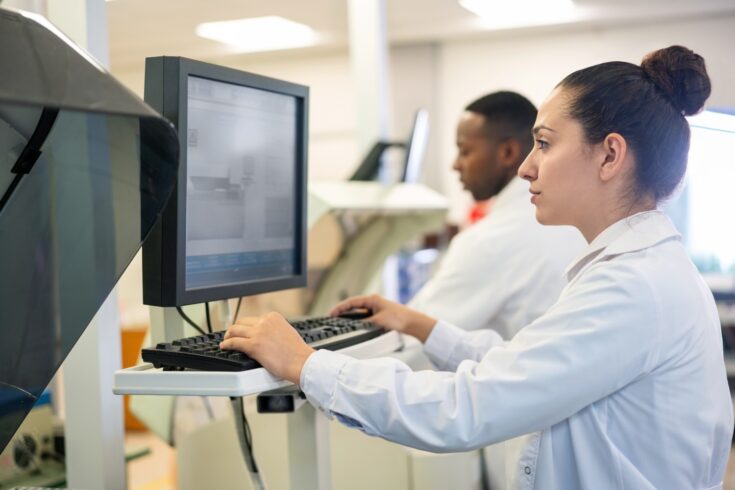BBSRC and NC3Rs have invested £4.7 million in 24 new projects focusing on alternatives to in vivo models in bioscience research.
The Biotechnology and Biological Sciences Research Council (BBSRC) and National Centre for the Replacement, Refinement and Reduction of Animals in Research (NC3Rs) have invested £3.7 million to develop the next generation of non-animal technologies (NATs).
UK Research and Innovation invested a further £1 million as part of its commitment to secure better health, ageing and wellbeing through the development of non-animal technologies to support ageing research.
Meeting research needs
Researchers highlighted a need for NATs that better model complex physiology through a recent survey report published by BBSRC and the Physiological Society.
The new investment addresses this need by combining:
- BBSRC’s remit to fund tools and technologies underpinning biological research
- NC3Rs mission to pioneer better science by supporting predictive, reproducible and cost-effective alternatives to the use of animals in research
The 24 projects awarded funding cover a wide range of disciplines and model types, including:
- human stem cell organoid systems
- vascularised organ-on-a-chip models
- novel in silico frameworks
Projects will focus either on the development of new NATs or enhancing confidence in existing technologies by improving the physiological relevance, throughput or breadth of application of current models.
Stimulating adoption and translation
A third of the projects will also feature an industrial project partner.
This will help address the lag between the development of a new technology and its adoption into routine use.
It will also help stimulate the translation and commercialisation of NATs.
Improving human and animal health
Dr Amanda Collis, Executive Director for Research Strategy and Programmes at BBSRC, said:
BBSRC welcomed the opportunity to work in partnership with NC3Rs to deliver this strategic programme.
This latest investment builds upon our well-established relationship and collaborative history of joint funding to drive research and innovation in the 3Rs.
It will also further enhance our understanding of the fundamental biological mechanisms of healthy systems across the whole life course.
The 24 projects supported by our investment offer great potential to deliver tangible impacts that improve human and animal health including ageing.
It will lead to reductions in the number of animals used for research and improve reproducibility of novel NATs.
Furthermore, by engaging industry partners in this programme of work, there is a very real opportunity to make significant progress around the translation and commercialisation of non-animal technologies.
A step change in bioscience research
Dr Cathy Vickers, Head of Innovation at the NC3Rs, said:
We are delighted to announce these exciting awards made in collaboration with BBSRC.
They evidence the potential for non-animal technologies to deliver a step change in bioscience research and reduce animal use.
The range of technology approaches we have funded is underpinned by the strength of expertise in non- animal technologies across the UK.
The industry partnerships formed will also be a key enabler to drive them into real world application.
We are looking forward to working with our grant holders and helping them to maximise their success.
Further information
The 24 projects
Developing the next generation of NATs
A high-throughput-compatible animal-cell-free miniaturised thymic organoid model for thymus biology studies and in vitro T cell production
Professor Clare Blackburn, The University of Edinburgh
In vitro digestibility: reducing animal use while meeting the demand to evaluate alternative proteins
Professor John Brameld, University of Nottingham
RoboHog: developing an in vitro gut model system of the porcine hindgut
Dr Anthony Buckley, University of Leeds
Developing a complex in vitro airway model to study respiratory viral pathogenesis, lung macrophage function and herpesviral vaccine vectors in pigs
Dr Gyorgy Feijer, University of Plymouth
A high-throughput spheroid fusion platform for the templated-assembly of 3D neuromuscular junctions
Dr Fabrice Gielen, University of Exeter
Understanding mechanisms driving lung disease caused by environmental particulate matter
Dr Nicholas Hannan, University of Nottingham
Developing a lung organoid signalome for real-time analysis of senescence-associated cellular cross talk
Dr Alison John, Imperial College London
A human ex vivo model of haemostasis: a replacement for rodent tail bleeding assays
Dr Sarah Jones, Manchester Metropolitan University
Production of a human growth plate organ-chip model of skeletal development
Professor Martin Knight, Queen Mary University of London
A platform to investigate multi-tissue crosstalk mediated by exercise induced soluble factors released from human skeletal muscle
Professor Mark Lewis, Loughborough University
A novel approach for modelling the healthy nose-brain axis in vitro
Professor Roisin Owens, University of Cambridge
A novel in silico framework for early mammalian embryo development
Dr David Richards, University of Exeter
Developing a human vascularised pancreatic islet on a chip
Dr Victoria Salem, Imperial College London
Novel in vitro platform to study molecular mechanisms of neurotransmitter release and synaptic plasticity
Dr Kirill Volynski, University College London
Developing a next generation in vitro 3D immune organoids system for studying vaccine-induced immune response and immune-ageing across the life-course
Dr Qibo Zhang, University of Surrey
Enhancing the capacity and confidence in existing NATs
Testing and validation of an in vitro 3D human chondrocyte model to replace animal use in mechanobiology research
Dr Emma Blain, Cardiff University
Advanced human pluripotent stem cell kidney organoid model for investigating development and disease
Professor Susan Kimber, The University of Manchester
Establishment of a cryo-bank of lineage-committed neural progenitor cells produced from engineered human pluripotent stem cells
Dr Tilo Kunath, The University of Edinburgh
Engineering circadian biology into induced pluripotent stem cell organ-on-a-chip models
Professor David Lee, Queen Mary University of London
Human organoid model to generate mucosal immune cell populations
Dr Joana Neves, King’s College London
Optimising human stem cell models to decipher signals and responses during organogenesis
Professor Jennifer Nichols, The University of Edinburgh
Epithelial barrier model: in silico modelling and high throughput assessment
Dr Malgorzata Wiench, University of Birmingham
Implementing an MEA platform in human neurones for studying age-related neural network dysfunction and testing dietary interventions
Dr Robert Williams, University of Bath
Organ-on-a-chip model of pulmonary arterial cell-cell interactions
Dr Beata Wojciak-Stothard, Imperial College London

